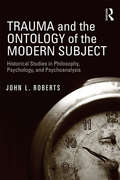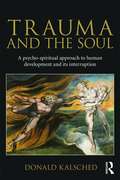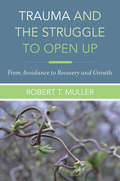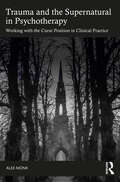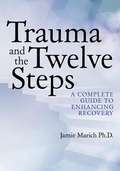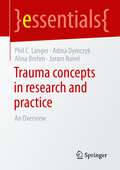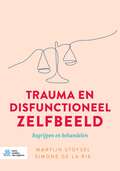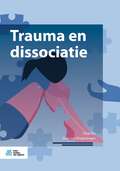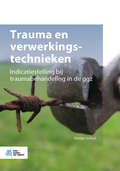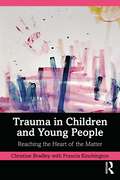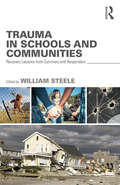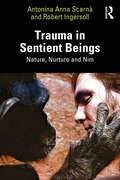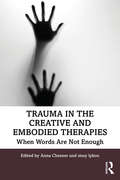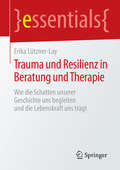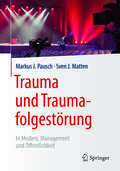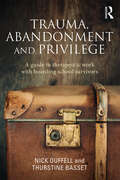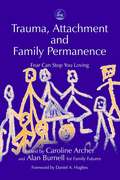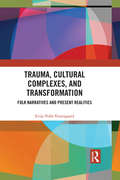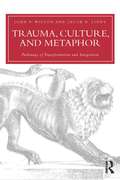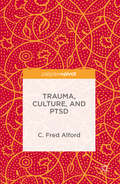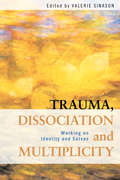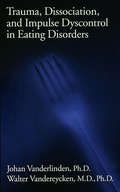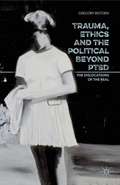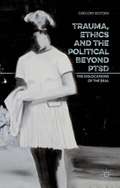- Table View
- List View
Trauma and the Ontology of the Modern Subject: Historical Studies in Philosophy, Psychology, and Psychoanalysis
by John L. RobertsRecent scholarship has inquired into the socio-historical, discursive genesis of trauma. Trauma and the Ontology of the Modern Subject, however, seeks what has not been actualized in trauma studies – that is, how the necessity and unassailable intensity of trauma is fastened to its historical emergence. We must ask not only what trauma means for the individual person’s biography, but also what it means to be the historical subject of trauma. In other words, how does being human in this current period of history implicate one’s lived possibilities that are threatened, and perhaps framed, through trauma? Foucauldian sensibilities inform a critical and structural analysis that is hermeneutically grounded. Drawing on the history of ideas and on Lacan’s work in particular, John L. Roberts argues that what we mean by trauma has developed over time, and that it is intimately tied with an ontology of the subject; that is to say, what it is to be, and means to be human. He argues that modern subjectivity – as articulated by Heidegger, Levinas, and Lacan – is structurally traumatic, founded in its finitude as self-withdrawal in time, its temporal self-absence becoming the very conditions for agency, truth and knowledge. The book also argues that this fractured temporal horizon – as an effect of an interrupting Otherness or alterity – is obscured through the discourses and technologies of the psy-disciplines (psychiatry, psychology, and psychotherapy). Consideration is given to social, political, and economic consequences of this concealment. Trauma and the Ontology of the Modern Subject will be of enduring interest to psychoanalysts and psychotherapists as well as scholars of philosophy and cultural studies.
Trauma and the Soul: A Psycho-spiritual Approach to Human Development and Its Interruption
by Donald KalschedIn Trauma and the Soul, Donald Kalsched continues the exploration he began in his first book, The Inner World of Trauma (1996)--this time going further into the mystical or spiritual moments that often occur around the intimacies of psychoanalytic work. Through extended clinical vignettes, including therapeutic dialogue and dreams, he shows how depth psychotherapy with trauma's survivors can open both analytic partners to "another world" of non-ordinary reality in which daimonic powers reside, both light and dark. This mytho-poetic world, he suggests, is not simply a defensive product of our struggle with the harsh realities of living as Freud suggested, but is an everlasting fact of human experience--a mystery that is often at the very center of the healing process, and yet at other times, strangely resists it. <P><P> With these "two worlds" in focus, Kalsched explores a variety of themes as he builds, chapter by chapter, an integrated psycho-spiritual approach to trauma and its treatment including: <P><P> images of the lost soul-child in dreams and how this "child" represents an essential core of aliveness that is both protected and persecuted by the psyche's defenses; Dante's guided descent into the Inferno of Hell as a paradigm for the psychotherapy process and its inevitable struggle with self-destructive energies; childhood innocence and its central role in a person's spiritual life seen through the story of St. Exupéry's The Little Prince; how clinical attention to implicit processes in the relational field, as well as discoveries in body-based affective neuroscience are making trauma treatment more effective; the life of C.G. Jung as it portrays his early trauma, his soul's retreat into an inner sanctuary, and his gradual recovery of wholeness through the integration of his divided self. <P><P>This is a book that restores the mystery to psychoanalytic work. It tells stories of ordinary patients and ordinary psychotherapists who, through working together, glimpse the reality of the human soul and the depth of the spirit, and are changed by the experience. Trauma and the Soul will be of particular interest to practicing psychotherapists, psychoanalysts, analytical psychologists, and expressive arts therapists, including those with a "spiritual" orientation. <P><P> Donald Kalsched is a Jungian analyst in private practice in Albuquerque, New Mexico, and a training analyst with the Inter-Regional Society of Jungian Analysts. He is the author of numerous articles in analytical psychology, and lectures widely on the subject of early trauma and its treatment. His books include The Inner World of Trauma (1996).
Trauma and the Struggle to Open Up: From Avoidance To Recovery And Growth
by Robert T. MullerHow to navigate the therapeutic relationship with trauma survivors, to help bring recovery and growth. In therapy, we see how relationships are central to many traumatic experiences, but relationships are also critical to trauma recovery. Grounded firmly in attachment and trauma theory, this book shows how to use the psychotherapy relationship, to help clients find self-understanding and healing from trauma. Offering candid, personal guidance, using rich case examples, Dr. Robert T. Muller provides the steps needed to build and maintain a strong therapist-client relationship –one that helps bring recovery and growth. With a host of practical tips and protocols, this book gives therapists a roadmap to effective trauma treatment.
Trauma and the Supernatural in Psychotherapy: Working with the Curse Position in Clinical Practice
by Alex MonkTrauma and the Supernatural in Psychotherapy explores how traumatic experience interacts with unconscious phantasy based in folklore, the supernatural, and the occult. Drawing upon psychoanalysis, anthropology, the arts, and esoteric philosophy, Alex Monk presents examples from folklore and literature to enrich his case illustrations which offer therapists important clinical perspectives on ways of working with clients who feel cursed and repeatedly manifest self-sabotaging states. The book examines the challenges that can arise when working with this client population and illustrates how to work through them while navigating potent transferences and projective identifications. Monk illustrates the way in which clients with developmental trauma may experience the supernatural and its psychic representatives as persecutory and/or a source of empowerment and healing. Trauma and the Supernatural in Psychotherapy also considers the historically conflicted relationship between psychoanalysis and the supernatural and proposes treatment perspectives which are not implicitly dependent upon a materialist paradigm. This book will be of great interest to psychotherapists and counsellors who have an interest in clinical work concerning the connection of relational trauma to unconscious forms of communication and uncanny phenomena arising between therapist and client.
Trauma and the Twelve Steps: A Complete Guide For Enhancing Recovery
by Jamie MarichGetting this book to press has been a bit of an uphill battle. In preparing this manuscript for publication, I ran into the same struggles that I encounter working as a clinician in the helping professions. Mental health publishers felt that this book was "too addiction." Addiction publishers felt it was "too mental health." Academic publishers called it too "colloquial," and self-help publishers too "academic."
Trauma concepts in research and practice: An Overview (essentials)
by Phil C. Langer Adina Dymczyk Alina Brehm Joram RonelTrauma is a key concept in many fields of psychology and medicine. Different understandings of trauma are at play here, which are sometimes blurred and usually have little relation to each other. In order to provide orientation in the discussion and to contribute to a reflected use of the concept of trauma in research and practice, this book presents central - clinical, psychosocial, transgenerational and collective - trauma concepts and demonstrates their significance in selected therapeutic, institutional, research and socio-political fields of practice by means of case studies
Trauma en disfunctioneel zelfbeeld: Begrijpen en behandelen
by Martijn Stöfsel Simone de la RieDit boek helpt behandelaren om het disfunctioneel zelfbeeld van hun cliënten te behandelen, en zo iemands veerkracht te versterken. Het boek is bestemd voor professionals in de ggz, zoals psychiaters, psychologen en sociaal verpleegkundigen. Het is daarnaast waardevol voor maatschappelijk werkenden die werken of gaan werken met cliënten met een disfunctioneel zelfbeeld.Trauma en disfunctioneel zelfbeeld - diagnostiek en behandeling laat zien dat een disfunctioneel zelfbeeld bij veel verschillende psychische stoornissen voorkomt. Dit boek verkent de oorzaken van zelfbeeldproblematiek, en bespreekt het onderkennen en vaststellen ervan.Daarnaast beschrijft het boek de verschillende behandelmogelijkheden. Dat doet het vanuit verschillende therapeutische stromingen: cognitieve gedragstherapie en psychodynamische therapie. Ook beschrijft het boek de protocollen om die behandelingen concreet uit te voeren. De verschillende behandelmethoden worden daarnaast helder geïllustreerd aan de hand van korte casussen.
Trauma en dissociatie
by De la Rie Snip-van WageningenDissociatie is een beschermingsmechanisme waarbij bepaalde herinneringen in de hersenen zijn verstoord, zoals het bewustzijn, geheugen of de waarneming van de omgeving. Bij het ervaren van onder andere hevige stress of een traumatische ervaring kan dissociatie optreden als vorm van zelfbescherming. Als dissociatie gedurende een langere periode of zelfs chronisch optreedt, is er sprake van een dissociatieve stoornis. Een dissociatieve stoornis komt over het algemeen alleen voor bij mensen die ernstige en vaak langdurige traumatische gebeurtenissen hebben ervaren - vaak in de jeugd - zoals mishandeling en/of verwaarlozing. Dissociatie is bijna altijd een bijverschijnsel van een posttraumatische stressstoornis (PTSS). Bij een dissociatieve stoornis wordt het functioneren in het dagelijks leven ernstig beperkt door de symptomen. De DSM-5 onderscheidt vijf dissociatieve stoornissen. (bron: gezondheidsplan.nl) Dit boek bespreekt trauma en dissociatie, een veel voorkomend fenomeen dat een complicerende factor kan zijn in de behandeling. Het is goed mogelijk om met goede diagnostiek, bestaande algemene therapeutische technieken en de richtlijn voor traumabehandeling dissociatie te kunnen onderkennen, en te behandelen. Dit boek helpt je (of je nu een meer ervaren of beginnend therapeut bent) daar zelfverzekerd mee om te gaan.
Trauma en verwerkingstechnieken: Indicatiestelling bij traumabehandeling in de ggz
by Martijn StöfselDit boek biedt een overzicht van de verschillende verwerkingstechnieken bij de behandeling van psychotrauma in de ggz. Trauma en verwerkingstechnieken - Indicatiestelling bij traumabehandeling in de ggz bespreekt de indicatiegebieden van de verschillende technieken en hun voor- en nadelen, zodat een behandelaar een meer beredeneerde keuze voor een techniek kan maken. Het uitgangspunt van de indicatiestelling is dat geen enkele verwerkingstechniek op alle punten beter is dan de andere verwerkingstechnieken.De inleidende hoofdstukken van Trauma en verwerkingstechnieken beschrijven hoe een goede traumabehandeling kan worden opgezet. Alle bekende evidence based en practice based behandeltechnieken worden kort benoemd. Vervolgens worden in drie afzonderlijke hoofdstukken de ‘grote drie’ verwerkingstechnieken uitgebreid besproken: Imaginaire Exposure, EMDR en Imaginaire Rescripting. Met behulp van casuïstiek worden de specifieke toepassingen van de genoemde verwerkingstechnieken geïllustreerd. Dit boek is bedoeld voor psychologen, psychiaters en andere professionals in de ggz, die mensen met traumaproblematiek behandelen.
Trauma in Children and Young People: Reaching the Heart of the Matter
by Christine Bradley Francia KinchingtonThis book offers a unique combination of an in-depth examination of attachment, a refined and tested model of Needs Assessment and Therapeutic Treatment plans and applies it to specific contexts including those of children in residential/foster care, young offenders, and unaccompanied asylum-seeking minors. Trauma in Children and Young People, the culmination of 40 years of experience in the field, focuses on the lives of children and young people who have experienced and live with the repercussion of early trauma. Accompanied with case studies, it examines how therapeutic intervention can enable children and young people to connect with their inner world of fragmented feelings and emotions and to develop a sense of ‘self’ that is real and has meaning. This book is intended for professionals working therapeutically with traumatised children, such as therapists, psychologists, psychiatrists, mental health workers, social pedagogues, child and youth care workers, social workers, residential care workers and foster carers, teachers, youth justice workers, and child refugee agencies.
Trauma in Schools and Communities: Recovery Lessons from Survivors and Responders
by William SteeleTrauma in Schools and Communities uses the power of first-hand, autobiographical narratives to illustrate the advantages and pitfalls of specific interventions implemented in the wake of tragedies. This book addresses short- and long-term impacts of traumatic events and the challenges both survivors and responders face, using case studies from the 1995 Oklahoma City bombing; the Gulf War; the September 11, 2001 terrorist attacks; Hurricanes Katrina and Rita; student suicides; the killing of a teacher; and the shootings at Sandy Hook Elementary, Virginia Tech, and Chardon, Ohio, among others. Each story features reactions and lessons that are unique and support specific, multidisciplinary, structured interventions that should be a part of every crisis team’s protocol and every community’s recovery effort. An appendix features a summary of the lessons learned, a "what if?" scenario, time-specific trauma recovery interventions, a fan-out meeting agenda, a traumatic event crisis intervention plan, and answers to questions commonly asked by students about suicide.
Trauma in Sentient Beings: Nature, Nurture and Nim
by Robert Ingersoll Antonina Anna ScarnàThis is a book about the bond between sentient beings. It explores the non-verbal space between two entities, and asks questions like: What is a healthy human being? Is it nature? Nurture? Nature via nurture? How are we born with personality traits, emotion, mood, language abilities, and intelligence? What do we know about attachment, family structure, and genetic inheritance?Dr Anna Scarnà and Robert Ingersoll use the life history of the chimpanzee, Nim Chimpsky and his family: parents Carolyn and Pan, companion Lilly, their daughter, Sheba, and an assortment of human carers, to explain the hallmarks of healthy human psychological development. What makes humans "human", and chimpanzees, "chimpanzees"? Do chimpanzees have a personality, or should we consider them to have a “chimpanality?”Robert, close friend and carer of Nim, gives the facts about Nim’s upbringing and first-degree relatives, and Anna reports with reference to theories of brain, personality, self, and language. Together they explain what can be drawn from psychological research and reanalyse the chimpanzee work from the 1960s and 1970s in order to honour and respect the memory of those animals.
Trauma in the Creative and Embodied Therapies: When Words are Not Enough
by Anna ChesnerTrauma in the Creative and Embodied Therapies is a cross-professional book looking at current approaches to working therapeutically and socially with trauma in a creative and embodied way. The book pays attention to different kinds of trauma – environmental, sociopolitical, early relational, abuse in its many forms, and the trauma of illness – with contributions from international experts, drawn from the fields of the arts therapies, the embodied psychotherapies, as well as nature-based therapy and Playback Theatre. The book is divided into three sections: the first section takes into consideration the wider sociopolitical perspective of trauma and the power of community engagement. In the second section, there are numerous clinical approaches to working with trauma, whether with individuals or groups, highlighting the importance of creative and embodied approaches. In the third section, the focus shifts from client work to the impact of trauma on the practitioner, team, and supervisor, and the importance of creative self-care and reflection in managing this challenging field. This book will be useful for all those working in the field of trauma, whether as clinicians, artists, or social workers.
Trauma und Resilienz in Beratung und Therapie: Wie die Schatten unserer Geschichte uns begleiten und die Lebenskraft uns trägt (essentials)
by Erika Lützner-LayDas handliche Buch beschreibt praxisnah und anhand von Beispielen die lebensprägende und generationenübergreifende Dynamik von Traumafolgen. Es zeigt, wie Heilung in Form eines ganzheitlichen Prozesses der Integration möglich wird. Die Autorin bezieht dabei Aspekte wie Systemtheorie, Tiefenpsychologie, Hirnforschung, Bindungstheorie, Traumatherapie und Körperpsychotherapie mit ein. Videosequenzen in Form von gesprochenen Vortragstexten ergänzen die Ausführungen und vermitteln ein lebendiges Bild dessen, was den entwicklungsfördernden Umgang mit Traumata gelingen lässt.
Trauma und Traumafolgestörung
by Markus J. Pausch Sven J. MattenDieses Buch bietet Lösungsansätze zur Angstbewältigung sowie bezüglich psychologischer Traumata und posttraumatischer Belastungsstörung mit besonderem Fokus auf die Zielgruppe exponierter Personen, die in Management, Medien oder allgemein in der Öffentlichkeit tätig sind und dadurch einer besonders starken Beobachtung und Bewertung durch ihr Umfeld ausgesetzt sind. Wie damit konstruktiv umgegangen werden kann und dies vielleicht sogar als Wettbewerbsvorteil genutzt sowie überwunden und persönliches Glück wiedererlangt werden kann, erläutert und unterstützt das vorliegende Werk.
Trauma, Abandonment and Privilege: A guide to therapeutic work with boarding school survivors
by Thurstine Basset Nick DuffellTrauma, Abandonment and Privilege discusses how ex-boarders can be amongst the most challenging clients for therapists; even experienced therapists may unwittingly struggle to skilfully address the needs of this client group. It looks at the effect on adults of being sent away to board in childhood and the problems associated with boarding, which have only recently been acknowledged by mainstream mental health professionals. This practice-based book is illustrated by case studies, diagrams and exercises and is divided into three parts: ‘Recognition; Acceptance; Change’. It aims to help readers understand the emotional processes of boarding and the psychological aspects of survival, outlining the steps toward recovery and the repercussions of survival. The book also explores how ex-boarders frequently struggle with intimate relationships with spouses and partners and offers interventions and strategies for those working with ex-boarder clients. Trauma, Abandonment and Privilege will be of interest to therapists, counsellors and mental health workers across the UK. It will also be relevant to those who are well acquainted with boarding schools based on the UK model, for example in Canada, Australia, New Zealand and India.
Trauma, Attachment and Family Permanence: Fear Can Stop You Loving
by Daniel Hughes Caroline Archer Alan BurnellFostered and adopted children can present major challenges resulting from unresolved attachment issues and early traumatic experiences. In this much-needed book, the contributors provide a variety of complementary perspectives on the needs of these children and their families, focusing on ways of integrating attachment theory and developmental psychology into effective practice. Examining multiple aspects of work with children who are unable to live with their birth families, the book includes contributions on the assessment, preparation and support needs of children and families, attachment and the neurobiological effects of trauma, effective management of contact with birth families and developmental challenges in school settings. The use of creative arts therapies, alongside developmental reparenting strategies as part of a long-term attachment therapy `package', are explored in some detail. A fictionalised family, used as a working example throughout Part 2, brings practical interventions to life: illustrating the Family Futures' inclusive approach, where adoptive and foster parents become pivotal members of the therapeutic team. In addition, contributions from real-life user families illustrate some of the challenges they face and demonstrate how the developmental attachment-based approach has worked for them. Bringing together a rich and innovative selection of ideas for adoption and fostering practice across the disciplines, this book will be a valuable resource for all involved in supporting substitute families.
Trauma, Autism, and Neurodevelopmental Disorders: Integrating Research, Practice, and Policy
by Jason M. Fogler Randall A. PhelpsThis book examines the diagnostic overlap and frequent confusion between the newly named DSM-5 diagnostic categories of neurodevelopmental disorders (NDDs), which include autism spectrum disorder (ASD), and trauma and stressor related disorders (TSRDs). These conditions are similar in that a) children with developmental disorders are particularly vulnerable to traumatic events and b) all have pervasive effects on the brain and development. Chapters provide a wealth of effective clinical, family, and school-based interventions, developed from established studies and important new findings. In addition, chapters use illustrative case studies to survey assessment challenges in today’s healthcare climate and consider alternative routes for improving correct diagnoses, identifying appropriate interventions, and referring proper targeted, evidence-based treatment and services. The book concludes with the editors’ recommendations for needs-based service access, including a more widespread use and acceptance of the Research Domain Criteria (RDoC) and the International Classification of Functioning, Disability, and Health (ICF) framework.Topics featured in this book include:The neurobiological contributors to posttraumatic stress disorder (PTSD).Fetal alcohol spectrum disorders (FASDs) and its diagnosis in children with a history of trauma.Interventions for trauma and stressor-related disorders in preschool-aged children.Reactive attachment disorder (RAD) and autism spectrum disorder (ASD) diagnosis and care in a cultural context.Special population consideration in ASD identification and treatment.Challenges associated with the transition to adulthood. Trauma and neurodevelopmental disorders from a public health perspective. Trauma, Autism, and Neurodevelopmental Disorders is a must-have resource for researchers, clinicians and related professionals, and graduate students in developmental psychology, child and adolescent psychiatry, public health, social work, pediatrics, and special education.
Trauma, Cultural Complexes, and Transformation: Folk Narratives and Present Realities
by Evija Volfa VestergaardTrauma, Cultural Complexes, and Transformation: Folk Narratives and Present Realities contributes to our understanding of how culturally traumatic events affect present day realities, and suggests the potential for healing by combining theories on psychological trauma, cultural complexes, and transformations. It draws on insight from a range of disciplines, including Jungian psychology, literary criticism, folkloristics, neurosciences, quantum physics, and social studies. Evija Volfa Vestergaard maps folk narratives of human encounters with extra-human entities as communications of cultural traumas suffered by tellers who are embedded in particular historical and geographical settings, focusing on the little-explored globally emerging cultures of Latvia and South Africa, alongside the United States of America. These cultural narratives form a bridge to a discourse on the social, political, and economic issues faced by these countries and the world at large. Vestergaard outlines the parallels between dreams and visions of individuals essential in healing, and the mythological legend genre serving the same function for groups and cultures, demonstrating that the aim of these open-ended communications is not only to reveal hidden truth, but also to stir our imagination about potentialities. Healing of traumas demands a world of global relatedness based on nurturing kinship, and such a transformation begins with imagining. Trauma, Cultural Complexes, and Transformation represents essential reading for academics and students of Jungian and post-Jungian studies, folklore, psychology, cultural studies and anthropology, as well as Jungian analysts and psychotherapists.
Trauma, Culture, and Metaphor: Pathways of Transformation and Integration (Psychosocial Stress Series)
by John P. Wilson Jacob D. LindyIn Trauma, Culture, and Metaphor, John Wilson and Jacob Lindy explore the language of both individual and collective trauma in an era dominated by globalization and interconnectedness. Through lucid, careful discussion, this important book builds a bridge between the etymology of trauma-related terms commonly used in Western cultures and those of other cultures, such as the Burundi-Rwandan ihahamuka. It also provides the clinician with a framework for working with trauma survivors using a cross-cultural vocabulary—one often based in metaphor—to fully address the experienced trauma and to begin work on reconnection and self-reinvention.
Trauma, Culture, and PTSD
by C. Fred AlfordThis book examines the social contexts in which trauma is created by those who study it, whether considering the way in which trauma afflicts groups, cultures, and nations, or the way in which trauma is transmitted down the generations. As Alford argues, ours has been called an age of trauma. Yet, neither trauma nor post-traumatic stress disorder (PTSD) are scientific concepts. Trauma has been around forever, even if it was not called that. PTSD is the creation of a group of Vietnam veterans and psychiatrists, designed to help explain the veterans' suffering. This does not detract from the value of PTSD, but sets its historical and social context. The author also confronts the attempt to study trauma scientifically, exploring the use of technologies such as magnetic resonance imagining (MRI). Alford concludes that the scientific study of trauma often reflects a willed ignorance of traumatic experience. In the end, trauma is about suffering.
Trauma, Dissociation and Multiplicity: Working on Identity and Selves
by Valerie SinasonTrauma, Dissociation and Multiplicity provides psychoanalytic insights into dissociation, in particular Dissociative Identity Disorder (DID), and offers a variety of responses to the questions of self, identity and dissociation. With contributions from a range of clinicians from both America and Europe, areas of discussion include: the concept of dissociation and the current lack of understanding on this topic the verbal language of trauma and dissociation the meaning of children’s art the dissociative defence from the average to the extreme pioneering new theoretical concepts on multiple bodies. This book brings together latest findings from research and neuroscience as well as examples from clinical practice and includes work from survivor-writers. As such, this book will be of interest to specialists in the field of dissociation as well as psychoanalysts, both experienced and in training. This book follows on from Valerie Sinason’s Attachment, Trauma and Multiplicity, Second Edition and represents a confident theoretical step forward.
Trauma, Dissociation, And Impulse Dyscontrol In Eating Disorders
by P.E.R.Published in 1997, Trauma, Dissociation, And Impulse Dyscontrol In Eating Disorders is a valauble contribution to the field of Psychotherapy.
Trauma, Ethics and the Political Beyond PTSD: The Dislocations of the Real
by G. BistoenThe contemporary psychiatric approach to trauma, encapsulated in the diagnostic category of PTSD, has been criticized for its neglect of the political dimensions involved in the etiology and treatment of trauma. By means of a philosophical and psychoanalytical analysis, the depoliticizing potential of the biomedical approach is tied to a more general 'ethical crisis' in post-traditional societies. Via the work of Lacan, Žižek and Badiou on the act and the event, this book constructs a conceptual framework that revives the ethical and political dimensions of trauma recovery.
Trauma, Ethics and the Political beyond PTSD: The Dislocations of the Real
by Gregory BistoenTrauma, Ethics and the Political beyond PTSD.
